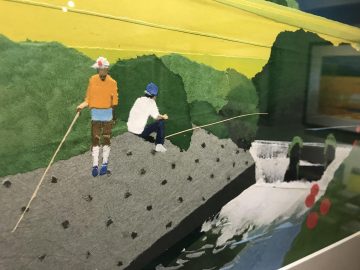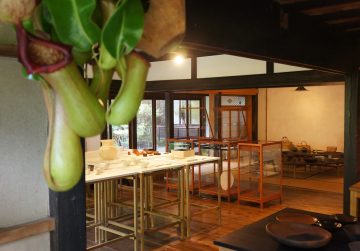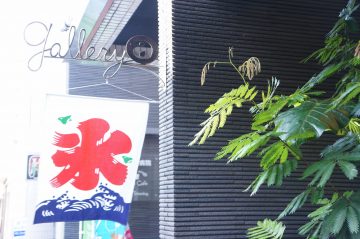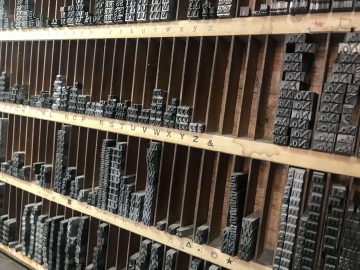Interview with Asae Soya | I want to depict "the extraordinary in the ordinary"

Artist Asae Soya has attracted attention for her paintings, which are filled with gentle light and color, as if guided by her own name. She also creates installations in which vivid colors resonate throughout the space, and video works in which colors and shapes seem to jump out of the paintings. She is currently residing in New York as a trainee of the Agency for Cultural Affairs, and is expanding the scope of her activities.
Originally from Kanagawa and based in Yokohama, she has deep ties to the local community, having received the Yokohama Culture Award (Culture and Arts Encouragement Award) and the Kanagawa Culture Award and Sports Award (Kanagawa Culture Award Future Award). Her latest exhibition in Yokohama, which will be held this summer, will surprisingly be held at the KAAT Kanagawa Arts Theatre, the city's performing arts hub.
She returned to Japan temporarily to prepare for the project, and we spoke to her about her creative origins and her thoughts on her latest work.
Interview & Text: Shinichi Uchida
Photo (Portrait): Masamasa Nishino
Composing landscapes using the "sounds of color"
※Soya Asae = S
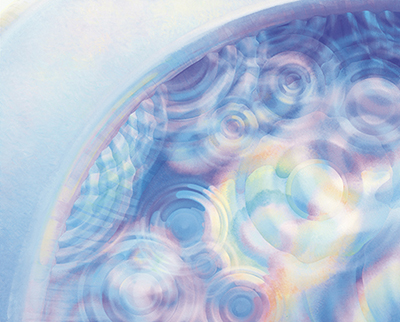
"Circles" / 2007 / Oil on cotton cloth / 130 x 162 cm
- Today, we will be talking about your past creations and your latest exhibition at KAAT Kanagawa Arts Theatre. Your work began as paintings, and has since developed into installations and videos that are in tune with your worldview. What do the things you "draw" mean to you?
S : I think I started drawing when I was about 3 years old, and color has always been important to me. I feel like every color emits a "sound." Some of these sounds are similar to musical instruments like the piano or violin, while others are like the sound of the wind blowing, the beating of the heart, or the hustle and bustle on a street corner. I have relied on these sounds to paint my pictures as if I were composing or tuning the landscape.
- Is that something like what's known as "synesthesia" (a perceptual phenomenon in which a certain stimulus produces an unusual kind of sensation, such as sensing colors in letters or sounds)?
S : I don't know the details myself. Maybe it's because I've always taken it for granted (laughs). For example, if you place one color next to another, the sounds of each color will resonate with each other. When I feel that reverberation and chord, and the best harmony suddenly emerges, I feel like the piece is complete.
- Many of your early paintings depict light flooding familiar water scenes, such as bathrooms and washrooms. Did you naturally choose such subjects when depicting the sensations you just described?
S : That's right. Water doesn't have a color in itself, but it can become any color depending on the light and the environment. It also brings out the properties of light more clearly through ripples and reflections. Water is also essential to human life -- you can see mineral water in front of you right now -- but at the same time, it is a very mysterious thing. I continue to be very interested in such "things that are too close to be seen."
- Your work gives off a fantastical impression, but it's not a fantasy that's far removed from reality?
S : I think you want to depict the "extraordinary in the ordinary." In your series "Circles," you depict water in a bathtub, and the light that illuminates the ripples on the surface of the water goes further and is reflected on the bottom of the bathtub. You could say that you are depicting the relationship between light and water, but there are also some parts where you have more clearly fed back your "discoveries" into your work.
- When I hear that, I feel like there is a connection to your recent installations that make bold use of space, even though the form is different.
S : No matter what method you use, the roots are connected. However, I think the reason I started making installations is because I have always had a strong interest in space. I also think this is related to my experience in Yokohama, where I have been based since my early days.
- Mr. Soya was born in Kanagawa, and after studying at Tokyo University of the Arts, he set up studios in places in Yokohama where creators gather, such as Kitanaka BRICK and ZAIM, where he worked.
S : Yes. I think it was influenced by the fact that I was able to meet artists who use a wide variety of methods of expression and architects who work on creating spaces. Come to think of it, Kitanaka BRICK was also the first place I created a space into a work of art.
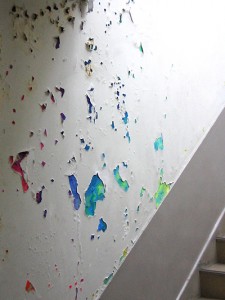
"Air Garden" 2006 / Dimensions variable Kitanaka BRICK & Kitanaka WHITE (Kanagawa)
- Your Hanging Garden (2006) is a blank space where two buildings face each other, and you scattered colorful paintings in the areas where the white paint has peeled off.
S : That work was born from the feeling that there was an unknown world of colors overflowing inside and beyond the walls. At ZAIM, I also had the opportunity to do live painting in an entire room in the building, and had the experience of being enveloped in my own painting. This also led to my solo exhibition "Ringing Colors" (2010) at the Shiseido Gallery. In this exhibition, I painted on sheets, then cut them into various shapes and pasted them down, which was a new challenge for me. Furthermore, the experience of cutting a large amount of sheets at this time gave me a new awareness of "lines," and I think it led me to develop those lines from then on.
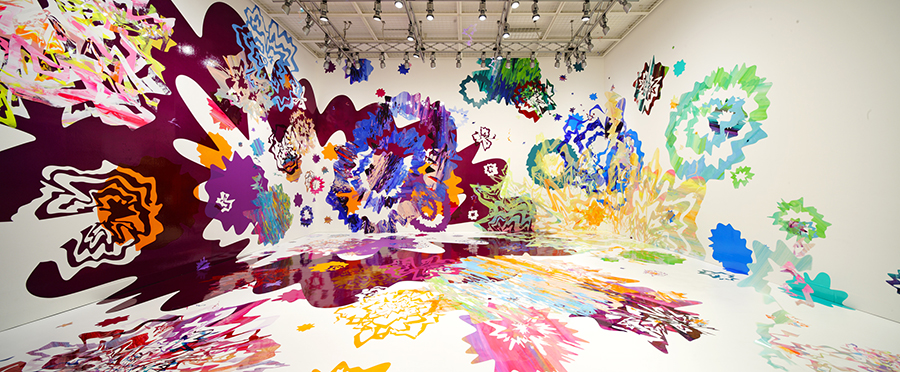
"Ringing Colors" / 2010 / Mixed media / Shiseido Gallery Photo: Nacása & Partners Inc
- So, they are all connected after all. The Ringing Colors series was followed by the Ringing Light series, which uses light-reflecting sheets, and you are now attempting to apply these to glass surfaces.
S : Yes, I do feel that it was Hikari that gave me this opportunity to meet him.
Painting Light / Art Painted with Light
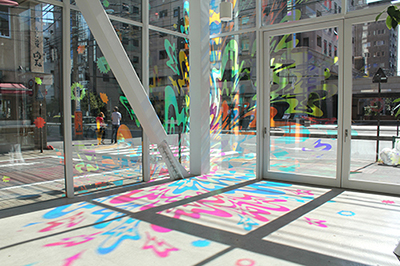
"Ringing Light" / 2013 / Film on the floor and walls / SHIBAURA HOUSE (Tokyo)
- You have continued to paint light with your paintbrush, but in works like Ringing Light, it seems like you are now "painting with light itself." Do you feel this is different or different for you?
S : I haven't completely switched from one to the other, and painting is still an important form of expression for me. However, I feel that the understanding I gained from observing light while painting - how light is applied, how it reflects, etc. - is something that I can use in my installations. Of course, I work with specialized technical staff, but I had already mastered the basics, like "if you do this, this kind of light will be created."
- Was your solo exhibition "Sorairo" (2013) at Art Tower Mito the culmination of your creative journey at that point? In particular, "Sora" became a hot topic, in which your own paintings were animated and danced around the room.
S : At that time, I was able to show my previous expressions in all seven rooms. I wanted to make the high-ceilinged room in the middle the place where something was being born. It was the center of creativity, the place that beats like a heart. That led to me trying my first video work. Specifically, I scanned the original drawings I drew on a computer, traced them, digitized them, and then combined them to create an animation.
-The picture isn't simply broken down into parts that move; rather, plant-like lines grow, extend and overlap; it gives the impression of an organic space that depicts creativity as a living thing.
S : I had an image of a forest of colors growing in the sky. Some people say it looks like a beating heart, blood vessels, or cells, and I think all of these are correct.
-Do you ever feel hesitant or unsure when attempting a completely unknown form of expression?
S : Of course, but I also have the advantage of not knowing how difficult it is (laughs). It makes me want to try things that I would hesitate to try if I knew too much. In the end, it's very difficult, but that experience often makes the next attempt easier and leads to a further step. With "Space," I was able to create visuals that even I had never seen before, so I'm wondering if I can feed that experience back into painting next time.
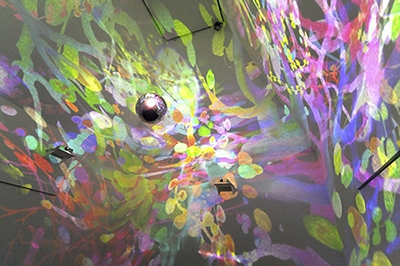
"Sora" / 2013 / Animation, Sphere / Contemporary Art Center, Art Tower Mito
photo: Nacasa & Partners Inc.
Sometimes, don't be afraid of friction and be yourself
- You are currently working as a researcher abroad for the Agency for Cultural Affairs at the International Studio & Curatorial Program (ISCP) in New York, where you are renting a studio to stay and create your work. We are interviewing you today during your time back in Japan. How was your experience there?
S : Artists from all over the world gather at ISCP, and each artist is given a room to work in. In addition to interacting with artists, I also have the opportunity to present my work to art professionals who often visit, which is a valuable experience.
- Do you get any inspiration from the city of New York?
S : I've mainly been based in Yokohama and Tokyo, and compared to those places, New York is more stimulating because of the diversity of values and the way they clash. Various beauties and ugliness assert themselves without easily compromising. When I come back after a long time, I realize the goodness of Japan in a different way, and my honest impression is "I feel so settled" (laughs), but of course there is a lot to gain from being there.
- What parts specifically?
S : For example, although conflicts and friction over values can be tough, on the other hand, it encourages me to "just do what I believe in without hesitation." While Japan has a tendency to avoid friction with others, I also get the impression that we tend to be bound by shackles that we ourselves have created, making us feel suffocated. It was a great benefit to be able to realize that it's okay to be more free from that. Well, I've been doing whatever I want up until now, but even more so now (laughs).
- Speaking of "tuning" and "chords" that you mentioned at the beginning of your talk today, it seems like "friction" is a troublesome element. What do you think?
S : Both harmonious chords and broken chords are beautiful, and the presence of both makes them stand out. Sometimes new energy can be born by deliberately destroying something. For example, the city of New York is overflowing with color, so if I were to do some public art there, I thought it might be good to express it in monochrome, which I haven't done before. When I create my works, I have always had the idea that putting something that is not "here" makes the space lively. It was a good experience to experience two contrasting urban cultures in terms of realizing this.
- Your stay will last until January 2015, but it seems like you still have a lot to experience.
S : That's right. I was surprised when people there were amazed at the drawings I do on a daily basis, asking me, "How can you create such delicate lines and colors?" I started to think that there might be something uniquely Japanese or unique about myself in the things I take for granted. I feel like I can see myself better now than I did before.
- Do you ever think about your own position in art history in relation to your predecessors?
S : I feel a connection with O'Keeffe in the sense that I depict something like universality, which is reached by pursuing personal sensations. Speaking of depicting light, the Impressionists are a given, and I think I was also strongly influenced by artists like Katsushika Hokusai in terms of the sense of balance in composition. I also love James Turrell and Bridget Riley, who are from a closer generation, and I feel a commonality with Ernesto Neto's expression in terms of his interest in physical sensations. If you can see "something that is very close but invisible," you can also see "something that is very far away." For me, my work is like a report of that, and I think that the predecessors I mentioned earlier are doing something similar. "Very close" does not simply mean around you, but closer, like inside your head, your body, or your senses themselves.
Emergeing the "ship of creativity" known as the theater
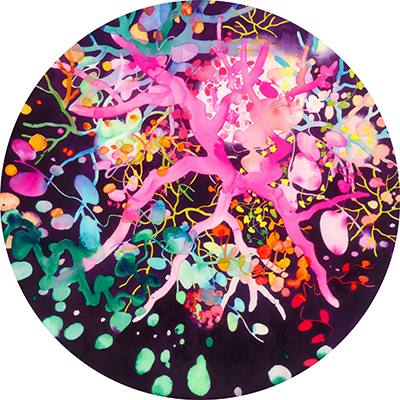
"Sora" / 2013 / watercolor
- Now, let's talk about your latest work, which will be appearing on the "stage" of the KAAT Kanagawa Arts Theatre from this summer. It seems that the exhibition will take advantage of the characteristics of this building, namely the open glass walls that surround it and the atrium that is enclosed by them - a 35m-high open space.
S : We will be creating a new piece, "Splash," using cutting sheets on the glass wall. We also plan to use a high-brightness projector to project "SORA" onto the large wall in front of the atrium in the evenings. I think "Splash" will look different in the daytime with sunlight and at night with the light from inside the building. "SORA" will be on a different scale than the space in Mito, so I'm really looking forward to it.
- You have worked on public art before. From the perspective of the creator, what is the appeal of public art that is different from spaces such as museums? If you have any thoughts about your experience living in New York, please share them with us.
S : It's true that in New York, there is art everywhere in public spaces. The range of expression is diverse, from masterpieces by big names to graffiti in the streets. Some graffiti is illegal, while others are legally organized. I feel that both have the appeal of allowing you to encounter artworks in your everyday life, unlike in a museum. But what I'm particularly happy about having this opportunity is that I can express my work in a "theater" called KAAT.
- Indeed, presenting artworks in a performing arts venue is a major feature of this event.
S : Theaters are places where diverse people gather to create a stage. That's why I'm sure there will be conflicts between various values and friction. But here, collaboration is taking place to overcome these conflicts and create one "good thing." I think it's like a "ship of creativity" where crew members with different areas of expertise and talents head for one destination. That's why this exhibition likens KAAT to that ship, with the splash-like "Splash" representing the waves the ship is raking through, and the "air" representing the source of creativity. The title of this exhibition, "Floating," comes from the desire to float such a ship of creativity in Yokohama. In addition, I think it overlaps with the image of Yokohama, a historic port city that is eager to support creators.
- Hearing that, it seems like the exhibition experience will be filled with a variety of different landscapes.
S : My creations are originally born from my interest in what happens when people create something. "SORA" is a symbolic work in that respect, and light and sound are systems that have been involved in creation since ancient times, including art and theater. My image of a theater is a place that shows you dreams. And I want that space to be a place that keeps you dreaming, no matter what kind of dream it is, for even a second longer so that you don't wake up. I think it would be great if my work could make the charm of theater more visible and function as a device to keep dreams alive. I would be happy if it could be an opportunity for not only regular theater-loving audience members, but also people who happen to pass by or pass by every day to come inside and wonder, "What is this?" The atrium at KAAT is a pleasant space to just stand in, and I think everyone has their own way of enjoying it. I would be happy if small children could enjoy it too.

- I have the impression that your work can be enjoyed naturally and without pretense by people of all ages. By the way, when you won the VOCA Grand Prize at the VOCA Exhibition 2002, you also won the "You're the judge!! Children's Prize in VOCA" at the same time.
S : Yes, I was happy when the children told me things like, "It's like we've entered a dream."
- By the way, do you feel that this production is uniquely interesting in the performing arts arena?
S : I think that people in the theater world have a great sense of unity in creating things in groups, but at the same time, they have the mobility to finish things vigorously. I wonder if it is due to the need to create a stage space that includes the actors' performances in a limited amount of time. Also, the world that has been polished in this way disappears before our eyes when the curtain opens and the finale comes - I am also attracted to the "beauty of that moment."
- Mr. Soya's work this time could also be said to be theatrical in the sense that it will decorate KAAT for a certain period of time and then live on in people's memories.
S : That's right. If my work can synchronize with the potential excitement of this place, it may create a space beyond my imagination. I want it to float in Yokohama like a light ship floating in the air. I have such expectations, and I am looking forward to it.
- This is exactly what you mentioned at the beginning, that "harmony will arise". I'm looking forward to seeing new scenes being created there, including the people who visit. Thank you for today!
▽Exhibition Information
Asae Soya "Floating"
http://www.kaat.jp/d/soya
Period: August to November 2014 (tentative)
Venue: KAAT Kanagawa Arts Theatre Atrium
Organized by: Kanagawa Arts and Culture Foundation
